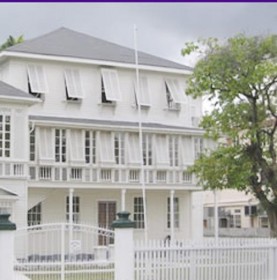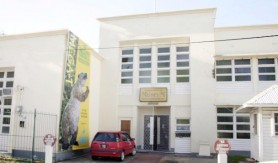By Clive W McWatt
Time lapse

After 1921 the publication of the journal had lapsed for a further twelve years until an issue of TIMEHRI appeared in December 1934 edited by George H Reid. The Daily Chronicle had taken over publication of the journal. In his editorial note in 1934, Reid commented that neither Dr Nunan, the last editor, nor the Society’s Directors, had made any effort at passing on the editorship. The single 1934 issue of TIMEHRI was to have the distinction of being the only issue published as the Fourth Series. This new issue of TIMEHRI was an event of considerable history for the colony; Sir Edward Denham, the Governor, wrote in his forward to the 1934 issue of the journal: “TIMEHRI has always been an organ of progress. Its mission has been to encourage belief in the colony, to indicate lines of advancement and development and to record the efforts of its pioneers.”
However, after this issue of the journal was produced, publication activity ceased for another decade during the period leading up to the Second World War.
Vincent Roth

Vincent Roth took up the editorship of TIMEHRI in 1944 and he continued to fulfil this role until his retirement in 1964. Roth’s life-long experience gained through colonial government service in the hinterland of Guyana, occasionally participating in politics and journalism, had equipped him to steer the RA&CS through the period of rebuilding of the Society’s premises after the devastating Georgetown fire of February 1945 and the changes after the Second World war.
Vincent Roth became extremely active in running the Society and was elected President in 1961. He was part-time Curator of the Museum from 1943 and kept up his interests in Amerindian ethnographic studies that were pioneered by his father, Dr Walter Roth. His other worthy project was the editing of a series of reprints of old books relating to the country. Roth retired from the Society in 1964.
This renewed editorship under Vincent Roth resulted in what would have been the ‘Fifth Series’ of TIMEHRI published by The Daily Chronicle. TIMEHRI No.26 appeared in November 1944 in time to mark the centenary of the founding of the RA&CS in 1844. Graham Cruickshank, the Society’s unofficial archivist, wrote an article to celebrate the Society’s hundred years of existence from 1844 to 1944 and the journal published centenary tributes from former Governors of the Colony. The 1944 issue of TIMEHRI has become a rarity in itself as stock copies may have been lost in the Great Fire which destroyed the Society’s premises three months later in February 1945.
Financial constraints
The earliest bi-annual volumes of TIMEHRI were published initially by James Thompson’s ‘Argosy’ Company Ltd from 1882–1921. The ‘Daily Chronicle’ took on publication of the journal from 1934.
Even though the production of TIMEHRI continued uninterrupted between 1882 and 1898, the Journal was plagued by financial stringency. The Journal was meant to bring in revenue for the Society but production costs were high and publication was later suspended on two or three occasions mainly on account of insufficient financial support and falling subscriptions. By 1897 the Journal was in debt to the Society for $3,000.00 which was an average loss of $300.00 per annum. The Directors had found it possible to underwrite the loss for fifteen years but support was withdrawn in 1898 bringing an end to the Second Series. The final TIMEHRI issue for 1899 carried only a record of the Society’s proceedings of meetings held from July 1898 to December 1899.
The revival of TIMEHRI under Nunan in January 1911 had prompted sufficient subscriptions and promises of articles. In 1911 fortunes revived to the extent that the journal subscription was reduced from $0.65 to $0.36 and continuous publication was further sustained from the revenues received from advertisements placed in the journal.
Two important RA&CS Committees had already been devolved to become the Chamber of Commerce and the Board of Agriculture, each publishing its own journal. In 1908 the Board of Agriculture, under the directorship of Professor J B Harrison, began publishing a quarterly Journal of the Board of Agriculture of British Guiana which aimed to deal only with practical agricultural subjects. Ten years on this journal was re-organised to bring it back to its original remit to write about agricultural matters. Harrison suggested that the RA&CS should make a subscription of 8 cents per annum on behalf each of the RA&CS members who may have wanted to receive copies of the Agricultural Board’s journal. In 1934 George Reid wanted to take it a step further and have the three journal titles – Agricultural Journal, Chamber of Commerce Journal and TIMEHRI – merged into a monthly publication.
Enduring title

It is however remarkable that the RA&CS managed to keep the TIMEHRI title alive for ninety three years between 1882 – 1975 when for forty of those years the Society’s organ was silent. It is thought that the quality of the articles declined with the dwindling expatriate population, although by the 1950s native Guyanese began to play a greater role in the RA&CS and the content of the journal.
In 1972 the name “Royal Agricultural and Commercial Society” was changed to “Guyana Society”; the “Royal” prefix was deleted after independent Guyana became a republic in 1970. Sometime before then the Society’s interests had already moved away from agriculture and commerce to become more of a learned society for the arts.
In the 1950s the Museum had its own publication, Journal of the British Guiana a Museum & Zoo of the Royal Agricultural and Commercial Society, latterly incorporating ‘Notes of anthropological, historical and zoological interest’. The Museum journal published in 1967 was the last to acknowledge in its title the Society’s enduring Royal patronage since its foundation in 1844.
The Guyana Society ceased to function in December 1975. The Journal of the Guyana Museum & Zoo published by the Guyana Museum adopted the name TIMEHRI for the Museum’s use. TIMEHRI: Journal of the Guyana Museum & Zoo No.45 was published in 1975, edited and produced by George E Burnham, the Museum’s Director. Burnham was keen to retain the title TIMEHRI. In his introduction to this edition of the Journal the Editor promises that: “The title will not be changed in the foreseeable future … “
The TIMEHRI title, however, remained dormant for another fifteen years until it was revived by the editors David Cox and Edward Hubbard in 1990. TIMEHRI: Journal of the Guyana Society, No.46 made its appearance in April 1990. The editorial describes the journal as a “…repository of information delivery with all aspects of Guyanese culture” – perhaps the last!
The title TIMEHRI has been out of use for some years since the demise of its parent organisations, the Royal Agricultural and Commercial Society and latterly the Guyana Society, but phoenix-like the title may yet be resurrected and reclaimed again for a new generation of readers.
Bibliographic record
The journal TIMEHRI has endured many vicissitudes over its long publication history and yet it remains a unique publication in the historical bibliography of Guyana. The late Lloyd Searwar, writing in 2004, regarded TIMHERI as a “priceless document … it exists as a group of publications of the utmost importance in the intellectual history of Guyana.”
TIMEHRI is an important source for historical research on Guyana once one has grappled with its bibliography. On account of the journal’s somewhat sporadic publication from 1882 to 1990, TIMEHRI publications can seemingly present a confused bibliographic record which may present a challenge for citation referencing. In searching for the title in the catalogues of the national and academic libraries of the UK and USA one finds inconsistency in description, date and volume numbering; the journal is sometimes treated as a serial or a monograph publication. The ‘Series’ system was discontinued in 1944 in order to avoid confusion and to make referencing easier. The researcher has also to be grateful to Paul A. Dorn, Librarian of the Dominion Colonial and Overseas Library in Los Angeles and Vincent Roth who in 1956 compiled a checklist providing a chronological structure to the series of volumes with supporting subject and author indices.
Recognition and legacy
TIMEHRI in its lifetime became the embodiment of the RA&CS and the flagship which launched the Society beyond the shores of Demerara. The journal secured a favourable reputation and recognition from academic and literary circles in Great Britain and America.
An early tribute was paid to the Journal when several volumes of ‘The “Timehri”, the Scientific Journal of Guiana’ were exhibited on the British Guiana stand at the 1893 World’s Columbian Commission Exposition held in Chicago. The exhibit won a diploma and medal awarded by The Board of International Judges – the citation read: “…This able journal also records much of the history of the Colony and the enterprise of its citizens and displays the intelligence zeal and public spirit manifested by the RA&CS. . . not only is to be commended for this exhibit of its work, but commands sympathy and support of all persons interested in development of the Sciences in South America.”
The journal became a standard ‘must read’ publication for Governors and new arrivals who came to work and reside in British Guiana. Society members eagerly awaited the appearance of a newly published volume. In the 1880s James Thompson, the proprietor of “The Argosy” (weekly), would write an exhaustive and thoughtful review of the contents of each new issue of the journal. In the Proceedings of the RA&CS meeting of December 1918, a letter from His Majesty King George V where the King expressly wished that his thanks should be conveyed to the Society for his copy of the TIMERHRI “Historical Illustrated Volume”, August 1918.
It is unfortunate that some the older volumes of TIMEHRI held by the National Library in Guyana are in poor physical condition due to the inadequate archival conservation conditions. However, copies of TIMEHRI are still well preserved in reserve collections in the older national and academic institutions of the United Kingdom – some copies of the journal held by the British Library still poignantly retain the RA&CS compliment slips or the names of previous owners inscribed on the flyleaves.
TIMEHRI was widely distributed to learned societies overseas in exchange for their publications. These publication exchanges in turn helped to enrich the RA&CS Library collections in Georgetown. The Great Fire in Georgetown, February 23, 1945, had devastated the Society’s premises and archives, and had it not been for the volumes of TIMEHRI that were published and distributed over a period of sixty years, the record of the body of work achieved by the Royal Agricultural and Commercial Society may have been lost altogether. TIMEHRI has therefore become one of the most important repositories of Guyana’s heritage and a unique bibliographical archive of Guyana’s commercial development and cultural history.





